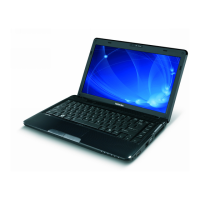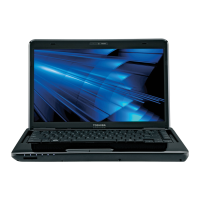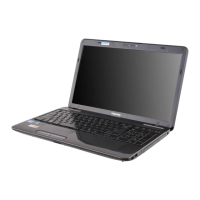
Do you have a question about the Toshiba Satellite L630 Series and is the answer not in the manual?
| RAM | Up to 8GB DDR3 |
|---|---|
| Graphics | Intel HD Graphics |
| Operating System | Windows 7 Home Premium |
| Weight | 2.1 kg (4.63 lbs) |
| Battery | 6-cell Lithium-Ion |
| Battery Life | Up to 4 hours |
| Optical Drive | DVD SuperMulti Drive |
| Wireless | Wi-Fi 802.11 b/g/n |
| LAN | 10/100 Ethernet |
| Webcam | Integrated Webcam |
| Connectivity | Wi-Fi, Ethernet |
| Processor | Intel Core i3/i5 |
| Display | 13.3-inch HD (1366x768) |
| Storage | Up to 500GB HDD |
| Ports | HDMI, VGA |
General safety and handling guidelines for optimal computer performance and safety.
Verifying hardware, documentation, and preinstalled software items.
Procedures for connecting power, opening display, and initial power-on.
How to turn off, sleep, hibernate, and restart the computer.
Options for system recovery, creating media, and restoring software.
Identification of components on the front, sides, and underside of the computer.
Detailed descriptions of processor, memory, disks, ports, and other hardware.
Information on preinstalled TOSHIBA utilities and applications.
Details on memory expansion, battery packs, and other optional devices.
How to use the touchpad, web camera, and microphone.
Using TOSHIBA Face Recognition, Optical Disc Drives, and writing CD/DVDs.
Managing audio settings and using wireless connectivity like LAN and Bluetooth.
Explanation of typewriter, function, and special keys.
Using FN key combinations for system control and special functions.
How to use the numeric keypad overlay for data entry and cursor control.
Understanding power conditions, indicators, and battery status.
Guidelines for battery safety, charging, monitoring, and replacement.
Explanation of power-up modes, utilities, and hot keys for power control.
How to use the HW Setup utility for system configuration and password management.
Setting boot order and configuring wake-up functions for keyboard and LAN.
Methods for identifying and resolving computer problems, including observation and checklists.
Guidance for resolving issues with power, drives, display, connectivity, and input devices.
Technical specifications for operating conditions and power input.
Understanding display controller functions and adjusting video mode settings.
Technical details of the Wireless LAN card, including standards and protocols.
Information on Bluetooth interoperability, health, and regulatory compliance.
Details on AC power cord requirements and certification agencies.
How to use the PC Health Monitor for system monitoring and diagnostics.
Legal notes regarding CPU performance, memory usage, and battery lifespan.
Definitions of key terms and abbreviations used throughout the manual.
Alphabetical index entries covering the manual's content and features.











